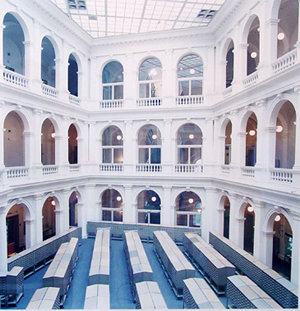Candida Hofer
dal 11/7/2006 al 30/9/2006
Segnalato da
11/7/2006
Candida Hofer
Irish Museum of Modern Art - IMMA, Dublin
Comprising some 10 works, this is the first solo exhibition in Ireland, by the internationally-renowned artist Candida Hofer. Her un-peopled interiors describe a selection of formal, public and cultural spaces, including palaces, libraries and museums, in cities such as Paris, Venice, Prague and New York. This exhibition presents work made while visiting Dublin in 2004, including photographs taken at the National Library of Ireland, Marsh’s Library, the Long Room in the Old Library of Trinity College and the Great Hall and Chapel of the Royal Hospital Kilmainham.

Dublin
The first solo exhibition in Ireland by the internationally-renowned German artist
Candida Hofer opens to the public at the Irish Museum of Modern Art on Wednesday 12
July 2006. Candida Hofer: Dublin presents 11 works made while visiting Dublin in
2004, including photographs taken at the National Library of Ireland, Marsh's
Library, the Long Room in the Old Library of Trinity College, the Merrion Hotel, and
the Great Hall, Chapel and Johnston Room of the Royal Hospital Kilmainham. Although
distinguished by titles indicating location, city, sequential number and date, these
works are not so much records of architecture or geography as they are endeavours at
capturing qualities inherent in the space - tranquillity, colour, light, atmosphere
and the ambiguous relationship between space and absence.
The types of architectural space to which Hofer is repeatedly drawn are, without
exception, public or semi-public places that have been constructed for specific
purposes; spaces in which we may expect to linger a while but not reside. Hofer has
photographed libraries, museums, theatres, churches, streets and zoos; places that
tend to favour anonymity over familiarity, strictly functional interaction over
intimate rapport. Traces of human activity are evident, in vacated chairs or
arrangements of tea services and cutlery, but people are rarely physically present.
Careful scrutiny of these images of ordered, but never immaculate spaces, inevitably
reveals the tell-tale marks of wear and tear left by people who occupied them
recently.
Irish Museum of Modern Art II, 2004, depicting the 17th-century chapel at the Royal
Hospital Kilmainham, epitomises Hofer's masterful interplay of form, content and
pattern. In this image, Hofer presents us with what initially appears as a scene of
archaic magnificence, of a chapel both pure and enduring in its splendour. Yet on
closer inspection, one notices the more prosaic elements of the space. Devoid of an
altar or other religious paraphernalia, one becomes aware that this is not a
functioning space of worship, but a deconsecrated chapel. Rather than detracting
from the image, the modern speaker system, light fittings and emergency exit sign
serve only to heighten Hofer's representation of this striking space. Hofer, perhaps
unwittingly, includes us in the image, in the surveillance camera which points
directly at us, thereby lending the otherwise stilled atmosphere its only suggestion
of life.
Although resembling a gracious salon in a private residence, with its ornate
wallpaper, glittering chandelier and hexagonal-motif carpet, the projection screen
and formally dressed tables in Merrion Dublin II, 2004, signify that this is a
business setting in which a presentation of some kind has been temporarily
suspended. Whether in between moments of preparation or takedown, we are not
certain. The un-staged furniture forms the centre of this composition in which they,
along with the architectural details, are the only subjects. One's attention is
drawn to the screen which almost entirely covers an elaborate gilt mirror, thus
blocking the reflection of the artist who would otherwise be visible in it. Hofer
subtly and conceptually implies humanity without physically including people. As
Hofer has herself commented, 'in the image absence is more present than presence'.
Hofer's frequently poetic impulse to keep searching for new sources of stimulus
saves her lucidly composed photographs from falling into banality. By offering us a
compelling examination of the nature of our own perception, she prompts us to
consider what looking really means. Through her singular style of photography, she
reinvests the act of seeing with a sense of wonder and surprise and gently invites
us to lose ourselves in the inner order of her spaces. At every turn, through her
remarkable intuition, Hofer taps into the pulsating essence of these un-peopled
spaces and brings them to life.
Candida Hofer was born in 1944 in Eberswalde, Germany, and is one of the leading
figures in contemporary German art photography. Having studied film at the
Kunstakademie Dusseldorf, she went on to study photography under Bernd and Hilla
Becher. Hofer was included in Documenta 11 in Kassel, Germany, in 2002. In 2003
she represented Germany, along with the late Martin Kippenberger, at the Venice
Biennale.
The exhibition is curated by Karen Sweeney, Assistant Curator: Exhibitions, IMMA.
The exhibition is supported by the Institut fur Auslandsbeziehungen e. V. The
exhibition opening is supported by the Embassy of the Federal Republic of Germany,
Dublin, and the Goethe Institut, Dublin.
A full-colour catalogue, with essay's by Caoimhi'n Mac Giolla Le'ith, curator and
critic, and Karen Sweeney, accompanies the exhibition.
Irish Museum of Modern Art
Dublin Irlanda
Royal Hospital Military Road
Opening hours: Tuesday to Saturday 10.00am - 5.30pm; except Wednesday 10.30am - 5.30pm; Sundays and Bank Holidays 12 noon - 5.30pm
Admission free



